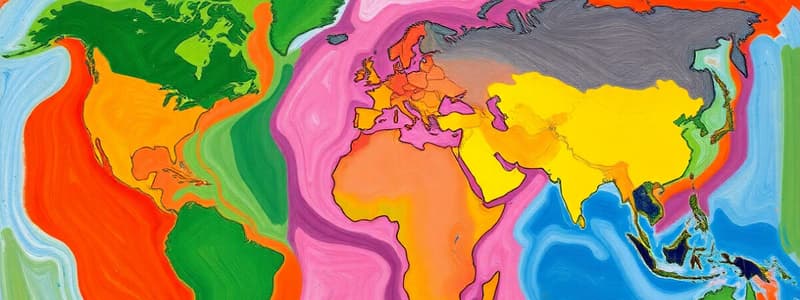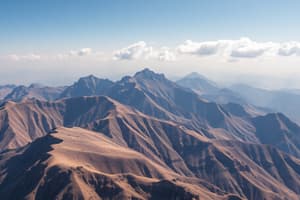Podcast
Questions and Answers
Which continent is the largest by land area?
Which continent is the largest by land area?
- South America
- Antarctica
- Asia (correct)
- Africa
What is a key characteristic of arid climate zones?
What is a key characteristic of arid climate zones?
- High temperatures and rainfall
- Cold temperatures and high humidity
- Low rainfall (correct)
- Moderate temperatures with distinct seasons
Which mountain range is known for being the highest in the world?
Which mountain range is known for being the highest in the world?
- Rockies
- Andes
- Himalayas (correct)
- Alps
What factor primarily influences population distribution globally?
What factor primarily influences population distribution globally?
What major effect does climate change have on the environment?
What major effect does climate change have on the environment?
Which river is the longest in the world?
Which river is the longest in the world?
What defines a peninsula?
What defines a peninsula?
Which of the following is a major concern of biodiversity loss?
Which of the following is a major concern of biodiversity loss?
Flashcards are hidden until you start studying
Study Notes
Physical Geography
- Continents: Seven major continents - Asia, Africa, North America, South America, Antarctica, Europe, Australia.
- Oceans: Five main oceans - Pacific, Atlantic, Indian, Southern, Arctic.
- Mountain Ranges: Notable ranges include the Himalayas, Andes, Rockies, and Alps.
- Rivers: Significant rivers - Nile, Amazon, Yangtze, Mississippi, and Danube.
- Deserts: Major deserts include the Sahara, Arabian, Gobi, and Kalahari.
Human Geography
- Population Distribution: Uneven global population; high densities in urban areas and river valleys.
- Cultural Geography: Study of cultural practices, languages, religions, and lifestyle variations.
- Political Geography: Focus on countries, borders, and geopolitical tensions.
- Economic Geography: Examines resource distribution, trade routes, and economic activities.
Climate Zones
- Tropical: High temperatures, high rainfall; found near the equator.
- Arid: Low rainfall; includes deserts.
- Temperate: Moderate climate with distinct seasons; found in mid-latitudes.
- Polar: Cold temperatures; found at the poles.
Environmental Concerns
- Climate Change: Global warming and its effects on weather patterns and sea levels.
- Deforestation: Loss of forests due to agriculture, logging, and urbanization.
- Biodiversity Loss: Extinction of species and loss of habitats.
- Pollution: Air, water, and soil pollution impacting ecosystems and human health.
Key Geographic Concepts
- Location: Absolute (coordinates) and relative (location in relation to other places).
- Place: Physical and human characteristics that define a location.
- Region: Areas defined by common features, such as cultural or physical traits.
- Movement: How people, goods, and ideas move between places.
Notable Geographic Features
- Islands: Distinct landforms surrounded by water; examples include Madagascar and Greenland.
- Peninsulas: Land surrounded by water on three sides; examples include the Iberian Peninsula.
- Plateaus and Plains: Elevated flat areas (plateaus) and broad flat lands (plains) with fertile ground.
Global Issues
- Urbanization: Increasing population in cities leading to challenges in infrastructure and services.
- Migration: Movement of people due to economic, social, or political factors.
- Globalization: Interconnectedness of economies and cultures around the world.
- Resource Management: Sustainable practices for managing natural resources amidst growing demands.
Physical Geography
- Seven continents: Asia, Africa, North America, South America, Antarctica, Europe, and Australia.
- Five oceans: Pacific, Atlantic, Indian, Southern, and Arctic.
- Major mountain ranges include the Himalayas, Andes, Rockies, and Alps, significant for their height and biodiversity.
- Important rivers: Nile (Africa), Amazon (South America), Yangtze (China), Mississippi (USA), and Danube (Europe), crucial for ecosystems and human settlements.
- Major deserts: Sahara (Africa), Arabian (Middle East), Gobi (Asia), and Kalahari (Africa), characterized by low rainfall and unique ecosystems.
Human Geography
- Global population distribution is uneven, with high densities concentrated in urban areas and fertile river valleys.
- Cultural geography examines practices, languages, religions, and lifestyle variations, providing insight into human behavior and societal development.
- Political geography investigates countries, borders, and geopolitical tensions, impacting international relations and conflict.
- Economic geography focuses on the distribution of resources, trade routes, and activities, influencing global trade and economy.
Climate Zones
- Tropical zones experience high temperatures and rainfall, prevalent near the equator, supporting diverse ecosystems.
- Arid zones have low rainfall and include vast desert areas, where survival challenges are prevalent.
- Temperate zones feature moderate climates with distinct seasons, found in mid-latitudes, supporting varied agriculture.
- Polar zones are characterized by extremely cold temperatures, located at the Earth's poles, impacting flora and fauna.
Environmental Concerns
- Climate change leads to global warming, affecting weather patterns and rising sea levels, with widespread environmental implications.
- Deforestation results from agriculture, logging, and urban growth, threatening habitats and biodiversity.
- Biodiversity loss is marked by species extinction and loss of habitats, putting ecosystems at risk.
- Pollution, including air, water, and soil contamination, adversely affects both ecosystems and human health.
Key Geographic Concepts
- Location can be absolute (specific coordinates) or relative (contextual positioning related to other areas).
- Place is defined by physical and human characteristics, creating a unique identity for locations.
- Regions are areas with common features, such as cultural practices or physical geography, facilitating comparative studies.
- Movement pertains to the flow of people, goods, and ideas, highlighting interconnectedness across locations.
Notable Geographic Features
- Islands are landforms completely surrounded by water, with examples like Madagascar and Greenland showcasing unique biodiversity.
- Peninsulas are land areas surrounded by water on three sides, with the Iberian Peninsula being a notable example.
- Plateaus are elevated flat areas, while plains are broad flat lands, both often with fertile soil, supporting agriculture.
Global Issues
- Urbanization leads to increased city populations, creating infrastructure and service challenges, including housing and transportation.
- Migration occurs due to economic, social, or political factors, impacting demographic trends and cultural exchanges.
- Globalization reflects the interconnectedness of economies and cultures, leading to shared innovations and challenges.
- Resource management emphasizes sustainable practices for managing natural resources amid rising consumption pressures.
Studying That Suits You
Use AI to generate personalized quizzes and flashcards to suit your learning preferences.




